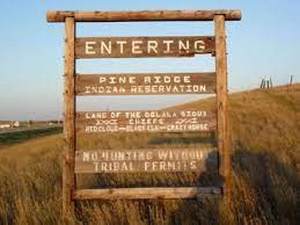![]()

AP EDITOR’S NOTE — On Feb. 27, 1973, members of the American Indian Movement took over the town of Wounded Knee, South Dakota, starting a 71-day occupation on the Pine Ridge Indian Reservation.
The standoff with the federal government grew out of turmoil within the Oglala Sioux Tribe as well as a protest of the federal government’s treatment of Native Americans.
It became violent at times, and two Native American men were killed.
The siege left a lasting impact on members of the Oglala Sioux Tribe and the future of Native American activism.
On the 50th anniversary of the start of the occupation, The Associated Press is republishing this 1973 story by reporter Terry Devine, in the language and style used by journalists of the era.
___
WOUNDED KNEE, S.D. (Feb. 28, 1973) — Militant Indians who took over this small town continued to hold 11 hostages Wednesday after one exchange of gunfire and unsuccessful attempts at negotiations, authorities said.
Gunshots were exchanged between the Indians and federal marshals earlier in the day, according to a Bureau of Indian Affairs official, but there were no reports of injuries.
An FBI spokesman said there were 11 hostages, ranging in age from 12 to 82.
John McCardy, an FBI agent at the scene, said attempts had been made to reach agreement on release of the hostages. However, he said, “At this time, there have been no meaningful negotiations.”
The Indians, who were demanding to see two U.S. senators concerning a list of demands, repeated earlier assurances that the hostages would not be harmed.
Spokesmen for the Indians also said a cease-fire had been arranged with the FBI.
Dick Wilson, president of the Oglala Sioux tribe that lives on the reservation, issued a statement accusing American Indian Movement members of “mob rule” and trying to “overthrow the tribal government.”
Wilson, 38, said the takeover of the historic community should be regarded as a criminal act and the demonstrating Indians should be “held responsible and prosecuted to the fullest extent of the law.”
The brief flurry of shots had come when a car carrying several Indians from Wounded Knee stopped about half a mile from a roadblock set up by the marshals, the FBI spokesman said.
He said the Indians, whose leaders said they were well-armed, emerged from the car firing rifles at the officers, and the marshals returned fire.
Indian leaders said there was other gunfire when Indians warned off cars that came too close to the village. Federal officers at the scene refused to discuss the shots and say whether they were returned. Another FBI official said only the Indians fired.
Marshals had personnel vehicles equipped with machine guns transported to Pine Ridge, 20 miles (32 kilometers) south of Wounded Knee, Wednesday, but the marshals declined to say if the vehicles would be taken to the site of the demonstration.
Spokesmen for the Indians said the occupying force had grown from 200 when the trouble started to 400 by Wednesday.
The takeover of the community, site of a bloody battle between the U.S. Cavalry and Sioux in 1890, began at about 10 p.m. EST on Tuesday. By the middle of the afternoon Wednesday, an FBI spokesman in Washington said, “The Indians are in charge of the town, hostages are there, roadblocks are up, the demands are the same.”
Clyde Bellecourt, of Minneapolis, a leader of the American Indian Movement, said the exchange of gunfire occurred when Indians fired warning shots over cars that came within a quarter of a mile of the village of about 100. He said federal marshals returned the fire.
Carter Camp, of Ponca City, Oklahoma, a national coordinator of AIM, said warning shots were fired by Indians at a low-flying airplane, but claimed it was not hit. Camp said the cease-fire was agreed upon before 2 p.m. EST.
Camp said the hostages would not be hurt unless authorities — who had surrounded the village — came too close.
The Indians — including members of AIM and of the Oglala Sioux tribe — held nine members of one family and a Roman Catholic priest. They demanded that Sens. Edward M. Kennedy, of Massachusetts, and J.W. Fulbright, of Arkansas, both Democrats, come to the 2,500-square mile (6,475-square kilometers) Pine Ridge reservation to discuss the Indians’ grievances.
The trouble allegedly started when the Indians broke into a trading post in the town 140 miles (225 kilometers) southeast of Rapid City and armed themselves with weapons and supplies. Their demands included an investigation of the dealings of the U.S. Department of the Interior and the Bureau of Indian Affairs with the Oglala Sioux. They also sought an ouster of the current leaders, including Richard Wilson, tribal chairman, who has feuded with AIM members in the past.
Bellecourt and Russell Means, another AIM leader, said the Indians were well armed. “We have high-powered rifles, shotguns, explosives and 14 hand grenades,” Means said.
“The government has two choices: either they attack and wipe us out like they did in 1890, or they negotiate our reasonable demands.”
Wounded Knee was the site of the last major confrontation between Indians and whites in the campaign to settle the West. More than 200 Indian women, children and old men were massacred on Dec. 29, 1890, by troops of the 7th Cavalry. That was the regiment led by Gen. George Custer that was annihilated 14 years before at the battle of the Little Big Horn in Montana.
